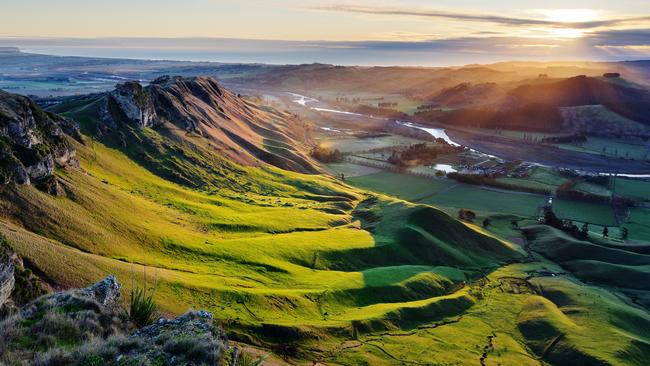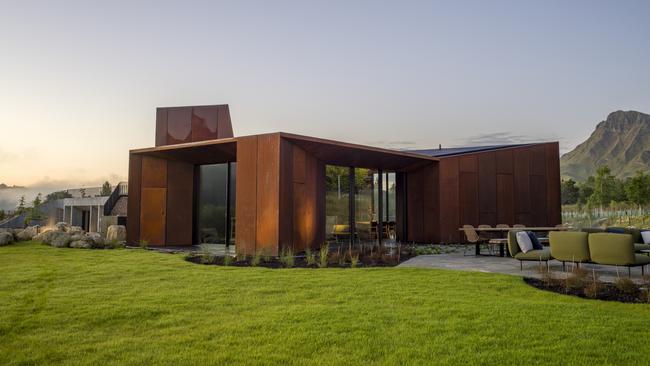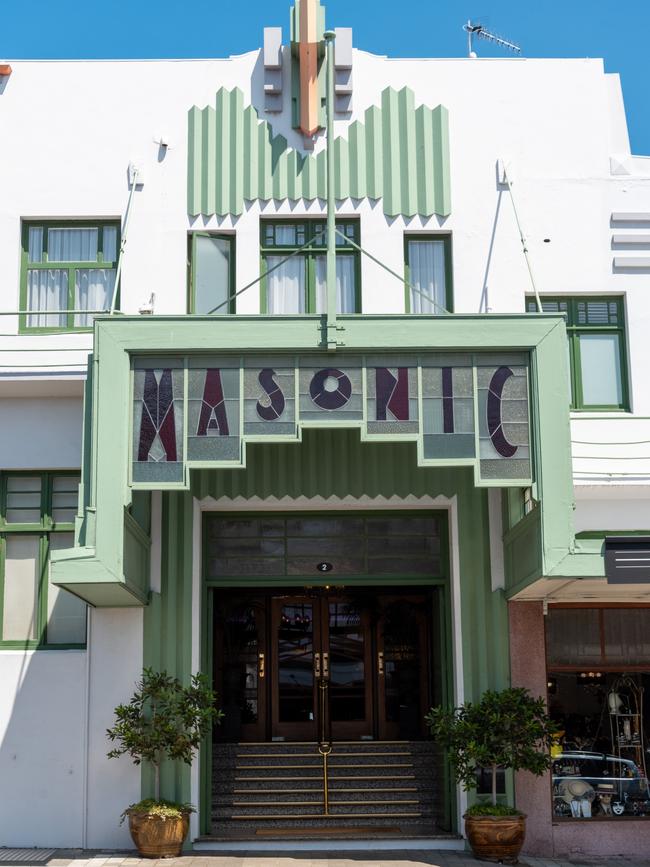With its space-age architecture and glorious landscape, this lodge retreat is one for the ages
You can’t help but be awed by this architecturally dazzling wonder-bunker.

It’s been exactly 10 years since I last saw the Tukituki River, and I remember the day clearly because the water was very cold and I was wading in it. Its source is the rugged Ruahine Range, inland from Hawke’s Bay on New Zealand’s North Island, where I was hiking. We were sloshing our way up the rain-swollen river, en route to a remote hut, the torrent constantly threatening to topple us. It’s worth noting that translated from Maori, “Tukituki” means to knock over, or demolish.
Despite the river’s best efforts we made it to Daphne Hut upright, where we hung sodden socks by a smoky fire, and went to sleep to the soundtrack of scurrying rats, who appeared to be in the middle of a large and urgent construction project.
Fast-forward a decade and Tukituki seems to have mellowed, and all evidence suggests I have too. I am observing my old adversary from behind the safety of floor-to-ceiling windows, nursing a glass of wine inside an opulent country retreat. The river shuffles past, looking wider and considerably more languid than I remember it. But perhaps it’s thinking the same about me? In any case, the only thing at risk of being demolished tonight is the rack of New Zealand lamb sizzling away in the oven.

Call me soft, but I can see certain advantages in trading a rat-ridden bush hut for Te Mania, the latest and most audacious addition to Black Barn Vineyard’s portfolio of Hawke’s Bay luxury lodges. You can’t help but be awed by this architecturally dazzling wonder-bunker, comprising two sets of concrete-clad sleepouts partially buried in the hillside, and an even more striking living and dining pavilion, coated in vast swathes of glass and Corten steel. Plonked under the dramatic, plunging limestone cliffs of Te Mata Peak, it could be easily mistaken for a modern art museum, and that’s before you even get inside.
“The house is quite ticky,” says our host, punching in the code that activates the automatic glass sliding doors and showing us in for an orientation.
“She means techy,” I whisper to my wife, who unlike me didn’t grow up in New Zealand and occasionally needs a translator. Our teenager assumes the role of tech-support, commandeering the iPad that controls the mood lighting, heating, state of the art audio system and the 2.6m wide projector screen that descends from the spotted gum ceiling. It takes him a while to even notice the pinball machine, which adds a welcome splash of colour and chaos to the charcoal-toned room, aided too by the pale timber and burgundy leather of the Scandi-style furniture, which look almost too expensive to risk sitting on.

The Wolf oven does delicious things to our lamb, and the designer kitchen also boasts Gaggenau cooktops (both gas and induction), plus a teppanyaki grill. You’d be mad not to spend balmy evenings outside by the fire and the ornamental lake, which gives the illusion of flowing like a river when raked by the breeze. Golden clumps of tussock and the tall, creamy plumes of native toetoe grass are interwoven across the manicured mounds that hide the subterranean bedrooms, all of which have ensuites with dual vanities, a shower that could fit an entire rugby team and a slightly too-techy toilet.
Sunrise is sublime, the first shards of sunlight seeping in through your bedroom blinds (controlled via a remote control beside your pillow), followed by a flood of warmth that fills the room and lures you outside. A good thing, too, because this thriving food and wine district is best experienced al fresco. Hawke’s Bay is New Zealand’s oldest wine region, and also the newest Great Wine Capital of the World. Summers are long, warm and dry, perfect for producing rich, Bordeaux-style reds. But the climate is kind year-round. We’re visiting in winter, and have no hesitation hiring e-bikes and hitting the Hawke’s Bay Trails, a 200km network of cycleways connecting wineries, orchards, quaint country pubs, farmers’ markets, wetlands and beaches.
Starting at the seaside village of Haumoana, we skirt the coast as the frothing sea lunges at our pedals. That thing I said about the weather being great should come with a disclaimer that violent storms are not uncommon. The region suffered widespread destruction from Cyclone Gabrielle in February 2023, and we ride past beach shacks perforated like Swiss cheese by stones hurled from the ocean during the regular squalls.

We work out pretty fast that cycling is a handy conduit for winery-hopping (the cycleways link no fewer than 25 cellar doors), so we dump our bikes outside the door of Craggy Range Winery and call in for a tasting. Cellar door associate Peter Manson explains how their grapes are grown on the free-draining soils of Gimblett Gravels, a stone-strewn river terrace created when the Ngaruroro River flooded and changed course in 1867. With a soil structure similar to Bordeaux, it’s considered the Holy Grail of Hawke’s Bay winemaking sites.
To demonstrate its magic, Manson starts furiously rubbing two Gimlett Gravels river stones together, looking inexplicably like he’s trying to start a fire at the table. He nearly succeeds. “Smell that,” he says, waving the stones under our noses. A wisp of smoke and the flinty scent of gunpowder wafts up. That smoky minerality is imparted into the vines as the stones heat up underground. Really puts the char into chardonnay. “Perfect with a cheese toasty,” says Manson.
Those Hawke’s Bay rivers sure know how to leave an impression.
Checklist
Getting there: Napier is a short flight from Auckland, Wellington or Christchurch. If driving, it’s 5.5 hours from Auckland; 4 hours from Wellington.
Stay: Te Mania sleeps up to eight guests, with rates starting at $3800 per night (minimum three nights). A concierge service can arrange experiences such as heli-picnics, guided fly fishing, in-house wine tasting, horse trekking, and a private chef. blackbarn.com/retreats

Eat: A newly renovated Craggy Range Restaurant opens in November, showcasing locavore produce and premium Hawke’s Bay wine (book a pre-dinner tasting session). The French/Italian-influenced Central Fire Station Bistro in Napier can’t stop winning regional restaurant awards, and occupies the shell of an old art deco fire station in the heart of the city. Hawke’s Bay is New Zealand’s fruit bowl, with over 20 million boxes of apples alone packed each year. Hit up Hawke’s Bay Farmers’ Market, or shout out to fruit pickers to toss you some choice pickings as you ride past orchards on your bike.


Do: Napier was levelled by New Zealand’s largest earthquake in 1931, and rebuilt almost entirely in art deco architecture. The story of its rebirth from the rubble is vividly told on a vintage car tour with Art Deco Napier. If visiting in February pack your best flapper dress and cloche hat for the annual Napier Art Deco Festival, which attracts 50,000 people. See the world’s largest mainland gannet colony at Cape Kidnappers, on a tour with Gannet Safaris Overland. Visit six wineries in six hours on a Cape Coast Winery Ride with Takaro Trails.

To join the conversation, please log in. Don't have an account? Register
Join the conversation, you are commenting as Logout